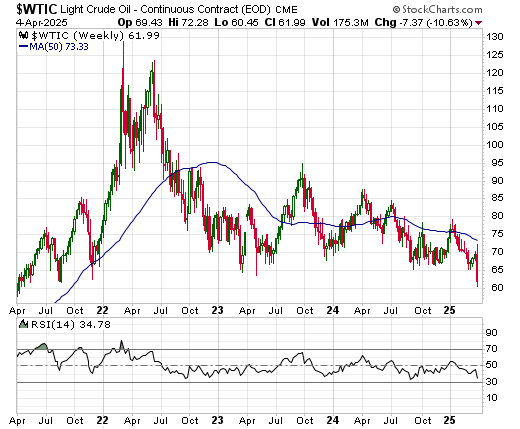[This blog post is an excerpt from a commentary published at www.speculative-investor.com on 6th April 2024]
The effects on the financial markets of Trump’s 2nd April announcement were similar to, albeit not quite as extreme as, the effects of the COVID lockdowns in March of 2020. Like the COVID lockdowns, what was announced on 2nd April constituted a massive government intervention that will disrupt global commerce and that to some extent came as a shock. Markets obviously were expecting widespread tariffs to be announced, but it is clear by the reaction that many market participants were surprised by the magnitude of the tariffs and/or the arbitrary way in which the tariff rates were determined.
Due to the adverse consequences for global economic growth, commodity prices plunged along with equity prices over the final two trading days of last week. For some industrial commodities the current price levels are not surprising to us in that we expected to see new cycle lows, but what we expected to unfold over the next few months occurred over the space of just two days.
For example, we expected that the rebound in the oil price from its early-March low would be followed by a decline to new cycle (multi-year) lows within the next few months, but the following weekly chart shows that last week the oil price plunged from a 1-month high to its lowest level in almost four years. In oil’s case, the negative reaction to the growth shock that potentially will stem from the tariffs was exacerbated by an OPEC announcement that the first three months of its planned production increases will be lumped together, meaning that OPEC oil production will increase by 411K barrels/day rather than the expected 135K barrels/day next month.
The oil price probably hasn’t bottomed, but by plunging to a new cycle low last week it has done as much as we thought it would do prior to the start of a cyclical upward trend.

For another example, a week ago we wrote that we perceived a lot of downside risk in the copper price, but we didn’t expect the downside risk to materialise immediately. Instead, the copper price fell 14% last week and removed any doubt that a multi-month price top was set via the spike up to US$5.40 during the preceding week.

The commodity and equity markets reversed course following their lockdown-related crashes in March-April of 2020 due to 1) the extent to which they were stretched to the downside and 2) the upward price pressure exerted by unprecedented monetary intervention. Based on Powell’s words late last week, the Fed is not close to doing anything supportive on the monetary front. Therefore, currently there is no reason to expect anything more bullish than a countertrend rebound.
 Print This Post
Print This Post
